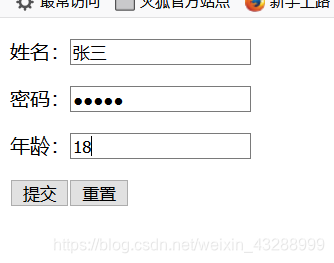第一种------散提
- 编写一个表单提交数据
<%@ page contentType="text/html;charset=UTF-8" language="java" %>
<html>
<head>
<title>$Title$</title>
</head>
<body>
<!--<a href="/admin/login.action">访问action跳到controller</a>-->
<!--第一种数据提交方式:单个数据,散提-->
<form action="${pageContext.request.contextPath}/admin/login.action" method="post">
<p>姓名:<input name="stuname"> </p>
<p>密码:<input type="password" name="stupwd"></p>
<p>年龄:<input name="stuage"></p>
<p><input type="submit" value="提交"><input type="reset" value="重置"></p>
</form>
</body>
</html>
- 在控制器组件LoginAction.java中输出提交的数据
package com.oracle.controller;
import org.springframework.stereotype.Controller;
import org.springframework.web.bind.annotation.RequestMapping;
@Controller
@RequestMapping("/admin")
public class LoginAction {
//所有方法必须注解,接受第一种数据提交方式:散提
@RequestMapping("/login")
public String mylogin(String stuname,String stupwd,int stuage){
System.out.println("----------"+stuname+"-------"+stupwd+"-------"+stuage);
return "main";
}
}
- 由于数据提交的方式是post与get不同无法将中文自动解析,需要在web.xml中添加字符编码过滤器


web.xml
<?xml version="1.0" encoding="UTF-8"?>
<web-app xmlns="http://xmlns.jcp.org/xml/ns/javaee"
xmlns:xsi="http://www.w3.org/2001/XMLSchema-instance"
xsi:schemaLocation="http://xmlns.jcp.org/xml/ns/javaee http://xmlns.jcp.org/xml/ns/javaee/web-app_4_0.xsd"
version="4.0">
<!--字符编码过滤器,配置在所有内容之前-->
<filter>
<filter-name>encode</filter-name>
<filter-class>org.springframework.web.filter.CharacterEncodingFilter</filter-class>
<init-param>
<param-name>encoding</param-name>
<param-value>UTF-8</param-value>
</init-param>
</filter>
<filter-mapping>
<filter-name>encode</filter-name>
<url-pattern>*.action</url-pattern>
</filter-mapping>
<!--注册Springmvc框架-->
<servlet>
<servlet-name>springmvc</servlet-name>
<servlet-class>org.springframework.web.servlet.DispatcherServlet</servlet-class>
<init-param>
<param-name>contextConfigLocation</param-name>
<param-value>classpath:springmvc.xml</param-value>
</init-param>
</servlet>
<servlet-mapping>
<servlet-name>springmvc</servlet-name>
<url-pattern>*.action</url-pattern>
</servlet-mapping>
</web-app>
- 运行结果


第二种------对象封装
- 在oracle目录下创建一个包pojo并在其下创建一个Student类
Student.java
package com.oracle.pojo;
public class Student {
private String stuname;
private String stupwd;
private int stuage;
public Student(String stuname, String stupwd, int stuage) {
this.stuname = stuname;
this.stupwd = stupwd;
this.stuage = stuage;
}
public Student() {
}
public String getStuname() {
return stuname;
}
public void setStuname(String stuname) {
this.stuname = stuname;
}
public String getStupwd() {
return stupwd;
}
public void setStupwd(String stupwd) {
this.stupwd = stupwd;
}
public int getStuage() {
return stuage;
}
public void setStuage(int stuage) {
this.stuage = stuage;
}
@Override
public String toString() {
return "Student{" +
"stuname='" + stuname + '\'' +
", stupwd='" + stupwd + '\'' +
", stuage=" + stuage +
'}';
}
}
- 创建一个新的表单,在LoginAction中创建一个新的方法
<!--第二种数据提交方式:提交的数据自动封装到对象中-->
<form action="${pageContext.request.contextPath}/admin/two.action" method="post">
<p>姓名:<input name="stuname"> </p>
<p>密码:<input type="password" name="stupwd"></p>
<p>年龄:<input name="stuage"></p>
<p><input type="submit" value="提交"><input type="reset" value="重置"></p>
</form>
//第二种数据提交方式:自动封装在对象中
@RequestMapping("/two")
public String two(Student stu){
System.out.println("--------"+stu.getStuname()+"--------"+stu.getStupwd()+"-------"+(stu.getStuage()));
return "main";
}
- 运行结果


第三种------别名应用
1.创建一个新的表单,在LoginAction中创建一个新的方法
<!--第三种数据提交方式:别名应用-->
<form action="${pageContext.request.contextPath}/admin/three.action" method="post">
<p>姓名:<input name="stuname"> </p>
<p>密码:<input type="password" name="stupwd"></p>
<p>年龄:<input name="stuage"></p>
<p><input type="submit" value="提交"><input type="reset" value="重置"></p>
</form>
//第三种数据提交的方式:提交的变量名与方法参数的名称不一样,需要专门的注解@RequestParam
@RequestMapping("/three")
public String three(
@RequestParam(value="stuname")
String name,
@RequestParam(value = "stupwd")
String pwd,
@RequestParam(value = "stuage")
int age
){
System.out.println("-----"+name+"----------"+pwd+"--------"+age);
return "main";
}
- 运行结果


第四种------使用request对象
1.创建一个新的表单,在LoginAction中创建一个新的方法
<!--第四种数据提交方式:request-->
<form action="${pageContext.request.contextPath}/admin/four.action" method="post">
<p>姓名:<input name="stuname"> </p>
<p>密码:<input type="password" name="stupwd"></p>
<p>年龄:<input name="stuage"></p>
<p><input type="submit" value="提交"><input type="reset" value="重置"></p>
</form>
//第四种数据提交方式:使用HttpServletRequest对象提取数据
@RequestMapping("/four")
public String four(HttpServletRequest request){
String name=request.getParameter("stuname");
String pwd=request.getParameter("stupwd");
int age=Integer.parseInt(request.getParameter("stuage"));
System.out.println("--------"+name+"--------"+pwd+"-------"+(age));
return "main";
}
- 运行结果


